Students get through AP Inter 1st Year Botany Important Questions 7th Lesson Sexual Reproduction in Flowering Plants which are most likely to be asked in the exam.
AP Inter 1st Year Botany Important Questions 7th Lesson Sexual Reproduction in Flowering Plants
Very Short Answer Questions
Question 1.
Name the component cells of the ‘egg apparatus’ in an embryo sac.
Answer:
One egg cell and two synergids.
Question 2.
Name the part of gynoecium that determines the compatible nature of pollen grain.
Answer:
Stigma
Question 3.
Name the common functions that cotyledons and nucellus perform.
Answer:
- Common function of cotyledons and nucellus is storage of reserve food.
- Nucellus provides food to the embryo sac.
- Cotyledons provide nourishment to the developing embryo.
Question 4.
Name the parts of pistil which develop into fruit and seeds.
Answer:
- Ovary develops into fiuit
- Ovules of ovary develop into seeds.
![]()
Question 5.
In case of ployembryony, if an embryo develops from the synergid and another from the nucellus which is haploid and which is diploid?
Answer:
- The embryo developed from the synergid will be haploid.
- The embryo developed from the nucellus will be diploid.
Question 6.
Can an unfertilised, apomictic embryo sac give rise to a diploid embryo? If yes, then how?
Answer:
- Yes. The diploid egg cell is formed without reduction division.
- The diploid egg develops into a diploid embryo without fertilisation.
Question 7.
Which are the three cells found in a pollen grain when it is shed at the three celled stage?
Answer:
One vegetative cell and two male gametes.
Question 8.
What is self-incompatibility?
Answer:
Inability of pollen grain to germinate on the stigma of the same flower is called self-incompatibility.
Question 9.
Name the type of pollination in self-incompatible plants.
Answer:
Cross- Pollination in Abutilon (Xenogamy).
Question 10.
Draw the diagram of a mature embryo sac and show its S-nucleate, 7-celled nature. Show the following parts; antipodals, synergids, egg, central cell, polar nuclei.
Answer:
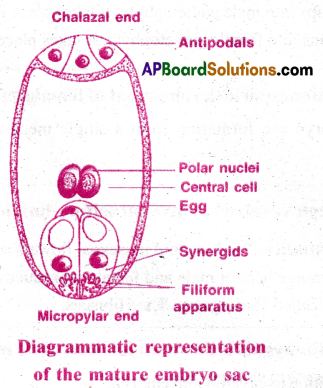
Question 11.
Which is the triploid tissue in a fertilized ovule? How is the triploid condition achieved?
Answer:
- Endosperm is the triploid tissue in the fertilised ovule.
- The haploid second male gamete fuses with the diploid secondary nucleus. Then it forms a triploid primary endosperm nucleus, which develops into endosperm after fertilisation.
Question 12.
Are pollination and fertilisation necessary in apomixis? Give reasons.
Answer:
- No. Apomixis is a type of asexual reproduction.
- In some species, the diploid egg cell is formed without reduction division and develops into an embryo without fertilisation.
- Apomixis occurs in the absence of pollinators, such as in extreme environments.
![]()
Question 13.
How is pollination carried out in water plants?
Answer:
Pollination in water plants occur by two ways.
- Epihydrophily: Pollination on the surface of water. Ex:Vallisnaria
- Hypohydrophily: Pollination under the surface level of water. Ex: Zostera.
Question 14.
What is the function of the two male gametes produced by each pollen grain in angiosperms.
Answer:
- One male gamete fuses with the egg cell to form a diploid zygote.
- The second male gamete fuses with the diploid secondary nucleus to form a triploid primary endosperm nucleus.
Question 15.
Name the parts of an angiosperm flower in which development of male and female gametophyte take place.
Answer:
- Microspore develops into male gametophyte. It takes place in Anther.
- Megaspore develops into female gametophyte. It takes place in Ovary.
Question 16.
What is meant by monosporic development of female gametophyte?
Answer:
The method of embryo sac formation from a single megaspore is termed as monosporic development.
Question 17.
Mention two strategies evolved to prevent self-pollination in flow ers.
Answer:
- Dicliny or unisexuaiity: Productionof unisexual flowers is called dicliny. Ex: Cocos
- Herkogamy: Arrangement of male arid female reproductive organs at different levels in a bisexual flower is called Herkogamy. Ex: Hibiscus.
Question 18.
Why do you think the zygote is dormant for some time in a fertilized ovule?
Answer:
- Zygote needs nutrition to develop into embryo.
- Hence until endosperm formed, it will be in dormant condition for sometime.
Question 19.
If one can induce parthenocarpy through the application of growth substances, which fruits would you select to induce parthenocarpy and why?
Answer:
- Banana and Grapes are parthenocarpy fruits.
- These fruits are useful in juice and jam industries because of more pulp.
Question 20.
Explain the role of tapetum in the formation of pollengrain wall.
Answer:
- Tapetum is the innermost layer in antherwall.
- It nourishes the developing pollen grains.
- Tapetal cells secrete sporopollenin, a constituent in hard outer layer (exine) of pollen grain.
- Sporopollenin can with stand high temperature, strong acids and alkali.
Question 21.
What is meant by scutellum? In which type of seeds is it present?
Answer:
- One large and shield shaped cotyledon is called scutellum.
- It is present in monocot seeds like grass.
Question 22.
Define with examples endosperttiic and non-endospermic seeds.
Answer:
- Endospermic seeds: The mature seeds with endosperm are called endospermic seeds.
Ex: All monocot seeds like Coconut, Castor. - Non-endospermic seeds: The mature seeds without endosperm are called non-endospermic seeds.
Ex:All dicot seeds like Bean, Pea.
![]()
Short Answer Questions
Question 1.
List three strategies that a bisexual chasmogamous flower can evolve to prevent self pollination (autogamy). [AP M-15]
Answer:
The three strategies of a bisexual flower to prevent self pollination are
- Dichogamy
- Herkogamy
- Self sterility
1) Dichogamy: The maturity of essential organs, that is, androecium and gynoecium at different times is called dichogamy. It is of two types.
a) Protandry: Male sex organs mature earlier than female sex organs. Ex: Sunflower.
b) Protogyny: Female sex organs mature earlier than male sex organs Ex: Datura
2) Herkogamy: Here, both androecium and gynoecium mature at the same time, but male and female reproductive organs are arranged in different directions or different heights.
Ex: Hibiscus, Gloriosa
3) Self Sterility: This is a genetic mechanism to prevent self pollination from fertilising the ovules. If the pollen grains fall on the stigma of the same flower, they won’t germinate.
Ex: Abutilon, Passiflora.
Question 2.
Given below are the events that are observed in an artificial hybridization programme. Arrange them in the correct sequential order in which they are followed in the hybridization programme, a) Re-bagging b) Selection of parents c) Bagging d) Dusting the pollen on stigma e) Emasculation f) Collection of pollen from male.
Answer:
b, e, c, f, d, a
b) Selection of parents
e) Emasculation
c) Bagging
f) Collection of pollen from male
d) Dusting the pollen on stigma
a) Re-bagging
Question 3.
Vivipary automatically limits the number of offsprings in a litter. How?
Answer:
- Vivipary is shown by the plants which grow in marshy places are called mangrooves.
- Vivipary seeds germinate while they are still attached to the mother plant.
- Seeds when fall on marshy places cannot germinate because of high salinity and more water conditions.
- In these plants, seeds germinate when they are in mother plant with limitation of space and nourishment in the embryosac.
- So vivipary automatically limits the number of offsprings in a litter.
Question 4.
Docs self incompatibility impose any restriction on autogamy? Give reasons and suggest the method of pollination in such plants.
Answer:
Reasons:
- Yes. Self incompatibility imposes restrictions on autogamy.
- Self incompatibility is a genetic mechanism.
- If pollen grains fall on the stigma of the same flower, they do not germinate.
- When the same pollen grain falls on the stigma of another flower, it will germinate preferring cross pollination.
- So in ‘self incompatible plants’, only cross pollination occurs. Ex: Abutilon.
![]()
Question 5.
What is polyembryony and how can it be commercially exploited?
Answer:
Commercial uses:
- Polyembryony: Development of more than one embryo in the same seed is called polyembryony.
- It can be used in tissue culture technique in propagating plants.
- It is helpful in developing new varieties such as Citrus and Mango.
- The plantlets obtained from these embryos are ‘virus free’ and has more vigour.
- Nucellar polyembryony is of great significance in horticulture.
- These embryos provide ‘uniform seedlings’ of parent type as obtained through vegetative propagation.
Question 6.
Are parthenocarpy and apomixis different phenomena? Discuss their benefits.
Answer:
1) Yes. Parthenocarpy and apomixis are different phenomena.
2) Parthenocarpy: Formation of fruit without fertilization of ovary is called parthenocarpy.
This phenomenon is applied for commercial production of seedless fruits.
Ex: Banana, Grapes.
This is more useful in juice industries.
3) Apomixis: Formation of seed without fertilization is called apomixis.
This process is used in production of hybrid seeds. Production of hybrid seeds is very costly.
If reproduction is continued by apomixis, farmer can keep on using this hybrid seeds to raise crop year after year and one does not have to buy hybrid seeds every year.
Question 7.
Why does the zygote begin to divide only after the division of Primary Endosperm Cell (PEC)?
Answer:
- Primary Endosperm Cell (PEC) divides repeatedly to form endosperm.
- Endosperm is a nutritive tissue.
- Zygote begins to divide only after certain amount of endosperm is formed.
- This is an adaptation to provide assured nutrition to the developing embryo.
Question 8.
The generative cells of two celled pollen divides in the pollen tube but not in three ceiled pollen . Give reasons.
Answer:
- In majority of angiosperms, the pollen grains are shed at two celled stage.
- They are vegetative cell and generative cell.
- After pollination, in the pollen tube the generative cell divides to give rise to two male gametes.
- But in some angiosperms, the pollen grains are shed at three celled stage.
- This is because the generative cell divides to give rise to two male gametes before pollination.
Question 9.
Discuss the various types of pollen tube entry into ovary with the help of diagrams.
Answer:
The pollen tube enters into the ovule by any of the three ways. [AP 22][TS 18]
- Porogany: Entry ofthe pollen tube into the ovary through micropyle. Ex: Hibiscus, Ottelia.
- Chalazogamy: Entry of the.pollen tube into the ovary through chalaza. Ex: Casuarina
- Mesogamy: Entry ofthe pollen tube into the ovary through funiculus or integuments Ex: Cucurbita.
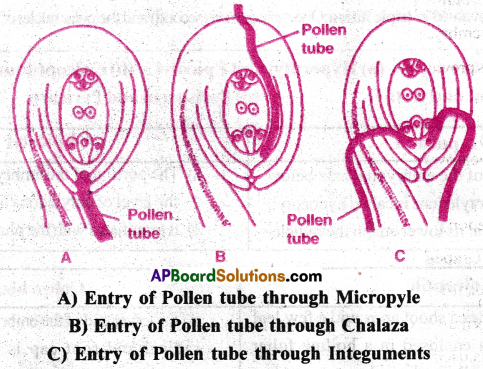
![]()
Question 10.
Differentiate between micro sporogenesis and megasporogenesfc. Which type of cell division occurs during these events? Namethc structures formed at the end of these 2 events.
Answer:
| Mierosporogenesis | Mega sporogenesis |
| 1) It is a process of formation of microspores from microspore mother cells after reduction division. 2) Four microspores are produced. All are functional. 3 ) This process occurs in anther of stamen. |
1) It is a process of formation of megaspores from mega spore mother cell after reduction division. 2) Four megaspores are produced. But only one is functional. 3) This process occurs in nucellus of ovule |
4) Meiosis occurs during micro sporogenesis and mega sporegenesis.
5) The structures formed at the end of these two events are Microspores and Megaspores.
Question 11.
What is bagging technique? How is it useful in a plant breeding programme?
Answer:
- Bagging Technique: During artificial hybridisation process, the stamens are removed from a bisexual flower. In the next step, the flower is covered with a suitable bag made of butter paper. This process is called bagging.
- It is done to prevent the deposition of unwanted pollengrains on the stigma of the flower.
Question 12.
What is triple fusion? Where and how does if take place? INsame the nuclei involved in triple fusion.
Answer:
- Triple F usion: Fusion of the second male gamete(n) with the diploid secondary nucleus (2n) of the embryosac results in the formation of a triploid primary endosperm nuclei (3n) (PEN).
- During this process three haploid nuclei undergo fusion. So it is known as triple fusion.
- The nuclei involved in triple fusion:Qne male gamete(second) and the polar nuclei of secondary nucleus
Question 13.
Differentiate between
(a) Hypocotyl and Epicotyi
(b) Coleoptile and Coleorhiza
(c) Integument and testa
(d) Perisperm and Pericarp
Answer:
| a) Hypocotyl | Epicotyi |
| 1) The portion of the embryonal axis below the level of cotyledons is called hypocotyl. 2) It terminates at its lower end in the radicle. |
1) The portion of the embryonal axis above the level of cotyledons is called epicotyi. 2) It terminates with the plumule or stem tip. |
| b) Coleoptile | Coleorhiza’ |
| Epicotyi has a shoot apex and a few leaf primordia enclosed in a hollow foliar structure called coleoptile. | At the lower end of the embryonal axis has the radical and root cap is enclosed in an undifferentiated sheath called coleorhiza |
| c) Integument | Testa |
| The ovule is covered by one or two protective layers called integuments. | After fertilisation, the outer integument of the ovule develops into testa. |
| d) Perisperm | Pericarp |
| Remnant of nucellus in the mature seed is called perisperm | The outer wall of a fruit is called pericarp |
Question 14.
What is meant by emasculation? When and why does a plant breeder employ this technique?
Answer:
- Emasculation Removal of stamens from a bisexual flower, before it demises and discharged the pollen grains is called emasculation.
- It should be done during bud condition.
- It is to prevent contamination of its stigma with unwanted pollen grains.
![]()
Question 15.
What is apomixis? What is its importance?
Answer:
1) Apomixis: Production of seeds without fertilisation is called apomixis.
- Apomixis is a form of asexual reproduction.
- In some species, diploid egg is formed without reduction division and it develops into the embryo without fertilisation.
- It is an assured reproduction in the absence of pollinators, such as extreme environments.
2) Importance of Apomixis:
- The desirable characters are not seggregated (separated). Because the seeds are produced without
- Superior and desirable characters can be maintained for many generations.
- Apomixis is very useful in commercial hybrid seed production.
Question 16.
Write briefly about the different types of ovules. [TS M-19]
Answer:
Ovules are 3 types.
They are 1) Orthotropous ovule 2) Anatropous ovule 3) Campylotropous ovule.
1) Qrthotropus Ovule: in this type, the micropyle, chalaza and funiculus are on the same vertical line.
Ex: Polygonum.
2) Anatropous Ovule: These are inverted ovules. The micropyle lies close to the funiculus.
It results 180° curvature alongside of the funiculus. Ex: Sun flower family.
3) Campylotropous: The body of the ovule is placed at right angles to the funiculus. Body of the ovule bends in such a way that micropyle comes towards the funiculus. Here, the embryosac is slightly curved.
Ex: Bean family.
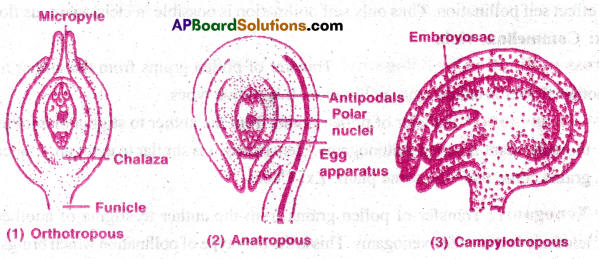
Long Answer Questions
Question 1.
Starting with the zygote, draw the diagrams of the different stages of embryo
a) Fertilised embryo sac showing zygote and primary Endosperm Nucleus (PEN)
b) Stages in embryo development in a dicot
Answer:
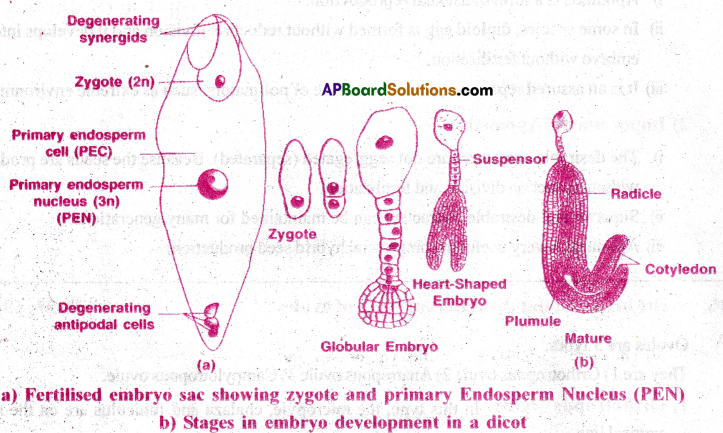
Question 2.
What are the possible types of pollinations in chasmogamous flowers? Give reasons.
Answer:
Chasmogaitiy: The pollination that occurs in opened flowers is called Chasmogamy. This is of two types. 1) Self pollination 2) Cross pollination.
1) Self pollination or Autogamy: Transfer of pollen grains from the anther to stigma of same flower is called self pollination. If the anthers and stigma of chasmogamous flower mature at the same time, self pollination occurs.
Cleistogamy is a type of pollination that occurs in closed flowers. Cleistogamous flowers never open. Anthers dehisce in the flower buds, pollen grains come in contact with the stigma to effect self pollination. Thus only self pollination is possible in cleistogamous flowers.
Ex: Commelina, viola .
2) Cross pollination or Allogamy: Transfer of pollen grains from the anther to stigma of another flower is called cross pollination. It is of two types.
i) Geitoiioganiy: Transfer of pollen grains from the anther to stigma of another flower of the same plant is called geitonogamy. Genetically it is similar to autogamy, since the pollen grains come from the same plant. Ex: Cocos.
![]()
ii) Xenogamy: Transfer of pollen grains from the anther to stigma of another flower of another plant is called xenogamy This is the only type of pollination which brings genetically different types of,pollen grains to the stigma. Ex: Borassus.
If the plants are continued to perform self pollination, it leads to inter breeding depression. So several plants develop contrivancies for cross pollination and achieve genetic divergence.
Question 3.
With a neat, labelled diagram, describe the parts of a mature angiosperm embryo sac. Mention the role of synergids. [TS May – 22][AP May- 19] [AP Mar- 19] [AP & TS M-16,17,19]
Answer:
The mature angiosperm embryosac has three parts.
- Egg apparatus
- Central cell
- Antipodals
1) Egg apparatus:
- Three cells grouped together at the micropylar end constitute the egg apparatus.
- They are two synergids and one egg cell.
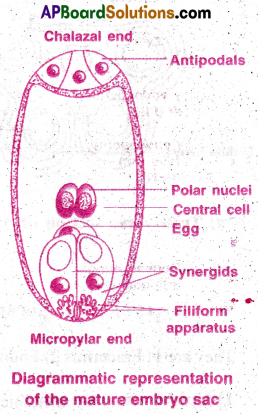
- The synergids with special cellular thickenings at the micropylar tip is called filiform apparatus.
- The middle largest cell is called egg or oospore.
2) Central cell:
- It is the largest cell of embryosac.
- It has two polar nuclei which fuse to form a single diploid secondary nucleus.
3) Antipodals:
- Three cells present at the chalazal end of embryosac are Called antipodals.
- These are smallest cells of embryosac.
- They degenerate before or after feritlisation.
- They are considered as vegetative cells of embryosac.
Role of Synergids:
- Synergids, nourish female gametophyte nutrients from surrounding nueellus;
- They help in the absorption of nutrients from the nueellus into the embryosac.
- They play an important role in guiding the pollen tube into Egg cell.
Question 4.
Draw the diagram of a microsporangium and label its wall layers. Write briefly about the wall layers. [AP M-20, 22] [AP,TS-18]
a) Transverse section of Anther
b) Enlarged view of Microsporangium
Answer:

Wall layers ofMicrosporangium are of 4 types:
They are
- Epidermis
- Endothecium
- Middle layers
- Tapetum
1) Epidermis: The outer, thick, protective layer of microsporangium is called epidermis.
The cells present between the two pollen sacs are thin walled and this region is called as stomium. This is useful for the dehiscence of pollen sacs.
2) Endothecium: It is below the epidermis and expands radially with fibrous thickenings. At maturity, these cells lose water and contract. They help in the dehiscence of pollen sacs.
These cells are hygroscopic in nature.
3) Middle layers: Below the endothecium, 1 to 5 layers of thin walled cells form the middle layers. They help in the dehiscence of anther.
![]()
4) Tapetum: The inner most wall layer is the tapetum. It encircles the sporogenous tissue.
The cells in this layer are large, thin walled & multinucleate.lt nourishes the developement of pollen grains. .
Question 5.
Describe the process of Fertilization in angiosperms. |-AP,TSM-I5||TSM-22|
Answer:
Fertilization in angiosperms: The fusion of male and female gametes is called Fertilization. The process of fertilization in angiosperms consists of five steps.
1) pollen tube into ovule: The pollen tube enters the ovule by any one of 3 ways.
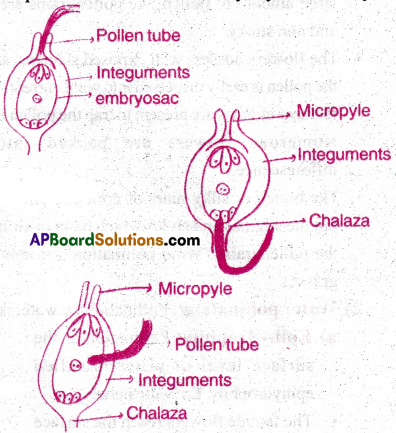
a) Porogamy: Entry of the pollen tube through micropyle is Porogamy.
Ex: Hibiscus
b) Chalazogamy: Entry of the pollen tube through Chalaza is Chalazogamy.
Ex: Casuarina
c) Mesogamy: Entry of the pollen tube through integuments is Mesogamy
Ex: Cucurbita
2) Entry of pollen tube into embryo sac: During theentry ofthe pollen tube into the embryo sac, the filiform apparatus of synergids guide the pollen tube.
3) Discharge of male gametes, into Embryosac: The pollen tube always enters the embryosac at the micropylar end of embryosac. After entering one of the synergids, the pollentube bursts and releases two male gametes into the cytoplasm of the synergids.
4) Syngamy: One of the male gametes fuses with the egg cell, resulting in the formation of diploid zygote.
This is called syngamy or true fertilisation
5) Triple fusion and double fertilisation: The second male gamete fuses with the diploid secondary nucleus Male and results in the formation of a triploid Primary 9ametes Endosperm Nucleus (PEN). This phenomenon is also known as double fertilisation. As this process involves the fusion of one nuclei of ‘haploid male gamete’ and two polar nuclei, this fusion is also known as triple fusion.
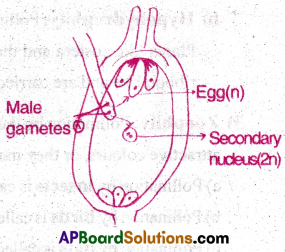
![]()
Question 6.
Write a brief account on agents of pollination.
Answer:
Pollination in plants occurs by two abiotic (wind and water) and one biotic (animals) agents.
1) Wind pollination: The pollination by wind is called Anemophily. Wind pollinated flowers produce large amount of pollen, the pollengrains are light and non sticky.

- The flowers possess well exposed stamens, so that the pollen is easily dispersed into wind current. Large feathery stigmas are present to trap the pollen easily.
Numerous flowers are packed into an inflorescence. - The bunch of silky hairs of com cob are nothing but the stigmas and styles which hang in air to trap the pollengrains. Wind pollination is common in grasses.
2) Water pollination: Pollination by water is called Hydrophily, It is of two types,
a) Epihydrophily: Pollination at the surface level of water is called epihydrophily. ExrVallisneria.
The female flowers reach the surface of water by its long stalk and the male flowers are released on the surface of water.
They are carried by water current to reach the female flowers and the stigma to perform pollination.
Pollination by water in Vallisneria.

b) Hypohydrophily: Pollination below the surface level of water is called hypohydrophily. Plants like zostera and their flowers remain submerged in water. Pollen grains are long, ribbon like and are carried inside the water and reach the stigma to achieve pollination.
3) Zoophily: Pollination by the agency of animals is called zoophily. These flower may be with attractive-colours, or they may produce nectar or fragrancy, pollengrains and may be sticky.
a) Pollination by insects is called entamophily.
b) Pollination by birds is called ornithophily.
c) Pollination by bats is called chiropteriphily.
d) Pollination by squirrels is called therophily.
e) Pollination by snakes is called ophiophily.
Exercise
Question 1.
Vivipary automatically limits the number of offsprings in a litter. How?
Answer:
- When all the seeds of the mangrove plant Rhizophora fall down in the habitat, they germinate and produce large number of seedlings.
- Over crouding leads to competition and struggle for existence.
- Few seeds of the plant only germinate in a viviparous manner while they are attached to the parent plant.
- The tall seedling fall down in the marshy habitat, avoid sinking down in the mud and germinate successfully.
- Thus vivipary automatically limits the number of offsprings in a litter.
Question 2.
Docs self incompatibility impose any restrictions on autogamy? Give reasons and suggest the method of pollination in such plants.
Answer:
- Self incompatibility is also known as self-sterility. It is a device to prevent in breeding.
- Definitely self incompatibility imposes restrictions on autogamy.
- Self-sterility is a genetic mechanism which prevents self pollination from fertilising the ovules by inhibiting pollen germination or pollen tube growth in the pistil.
- In such plants cross pollination is the only device to occur.
![]()
Question 3.
What is polyembryony and how can it be commercially exploited?
Answer:
- Production of more than one embryo in a seed is called poly embryony. Ex: Citrus and Mango.
- These embryos are the apomictic embryos.
- Cultivation of hybrids has tremendously increased productivity.
- One of the problems of hybrids is that hybrid seeds have to be produced every year.
- If the seeds collected from hybrid plants are sown, the plants in the progeny donot maintain hybrid characteristics.
- Production of hybrid seeds is costly and too expensive for the farmers.
- If these hybrids are made into apomictics there is no seggregation of characters in the hybrid progeny.
- Then farmers can keep on using the hybrid seeds to raise new crop year after year and he does not have to buy hybrid seeds every year.
Question 4.
Are parthenocarpy and apomixis different phenomena? Discuss their benefits
Answer:
- Production of fruit without fertilisation of the ovary is called parthenocarpy.
- The parthenocarpic fruit are seedless and commercially more valuable. Ex: Grapes and Banana.
- Parthenocarpy may be natural or induced.
- By using gibberellins several varieties of fruits of commercial value are produced.
- They are now in practice in the field of pomiculture.
- Production of seeds without fertilisation is called apomixis.
- It is a method of asexual reproduction. There are several ways of production of apomictic seeds.
- In some species, the diploid egg cell is formed without fertilisation.
- In citrus and mango, some nucellar cells surrounding, the embryo sac start dividing, protrude into the embryo sac and develop into embryos.
- In such species the seed contain many embryos, the condition is referred to as poly embryony.
- If these embryos are from hybrid parents, the hybrid characters will be maintained in the progeny also with out any seggregation.
- So the farmer can keep on using these apomictic seeds to raise new crop year after year and he does not have to buy hybrid seeds every year.
Question 5.
Why does the zygote begin to divide only after the division of Primary endosperm cell (PEC)?
Answer:
- After fertilisation the primary endosperm cell divides repeatedly and forms a triploid endosperm tissue.
- The cells of this tissue are filled with reserve food materials and used for the nutrition of the developing embryo.
- Because of this reason the zygote begin to divide and becomes an embryo only after the division of primary endosperm cell.
Question 6.
The generative cell of two-celled pollen divides in the pollen tube but not in a three-celled pollen. Give reasons.
Answer:
- In some plants, pollen grains are shed at two celled condition.
- One cell is vegetative cell and the other is generative cell.
- During the growth of the pollen tube in the stigma, the generative cell divides and forms two male gametes.
- In some other plants, the pollen grains are shed in three celled condition, pollen tubes carry the two male gametes from the beginning.
![]()
Multiple Choice Questions
Question 1.
Apical bud of shoot is
1. Radicle
2. Coleorhiza
3. Coleptile
4. Plumule
Answer:
4. Plumule
Question 2.
Single flower pollination is
1. Autogamy
2. Allogamy
3. Cross-pollination
4. Xenogamy
Answer:
1. Autogamy
Question 3.
Triple fusion takes place between
1. One egg cell and two male gametes
2. Two egg cells and one male gamete
3. One male gamete and two polar nuclei
4. 0ne egg cell and two polar nuclei
Answer:
3. One male gamete and two polar nuclei
Question 4.
Pollen tube is madeup of
1) Sporopollenin
2) Lignosuberin
3) Pectolignine
4) Pectocellulose
Answer:
4) Pectocellulose
Question 5.
The growth of pollen tube is directed into the embryosac tli rough synergid by
1) Antipodals
2) Polar nuclei
3) Filiform apparatus of egg cell
4) Filiform apparatus of synergid
Answer:
4) Filiform apparatus of synergid
Question 6.
The fusion of male and female gametes in the embryosac is called
1. Triple fusion
2. Syngamy
3. Double fertilisation
4. Zooidogamy
Answer:
2. Syngamy
Question 7.
In Castor & Maize
1) Autogamy & allogamy are not prevented
2) Geitonogamy is privented
3) Autogamy is not prevented
4) Geitonogamy is not prevented
Answer:
4) Geitonogamy is not prevented
Question 8.
A bisexual flower which never opens up in its life span and pollination in it is known as
1) autogamy
2) allogamy
3) homogamy
4) cleistogamy
Answer:
4) cleistogamy
Question 9.
Aneniophillous flowers have
1) sessile stigma
2) small smooth stigma
3) coloured flower
4) large feathery stigma
Answer:
4) large feathery stigma
![]()
Question 10.
Total number of nuclei involved in double fertilization
1) 5
2) 4
3) 3
4) 2
Answer:
1) 5
Question 11.
Diploid nutritive tissue in theanther is .
1) Endosperm
2) Perisperm
3) tapetum
4) nucellus
Answer:
3) tapetum
Question 12.
The end products of sexual reproduction are
1. Androecium and gynoecium
2. Inflorescence and flower
3. Calyx and corolla
4. Fruits and seeds
Answer:
4. Fruits and seeds
Question 13.
The hard exine layer of pollen grain is made up of
1. Cellulose
2. Pectin
3. Chitin
4. Sporopollenin
Answer:
4. Sporopollenin
Question 14.
In over 60% of the angiosperms, pollen grains are shed at
1. 3-celled stage
2. 2-celled stage
3. 4-celled stage
4. 1-celled stage
Answer:
2. 2-celled stage
Question 15.
The centre of each young microsporangium is occupied by
1. Tapetum
2. Sporogenous tissue
3. Endothecium
4. Stomium
Answer:
2. Sporogenous tissue
Question 16.
Male gametophyte of an angiosperm is represented by
1. Magaspore
2. PMC
3. Embryosac
4. Microspore
Answer:
4. Microspore
Question 17.
Parthenium entered into India as a seed contaminant of
1. Rice
2. Wheat
3. Bajra
4. Maize
Answer:
2. Wheat
Question 18.
The common name carrot grass is given to
1. Oryza
2. Parthenium
3. Triticum
4. Tridax
Answer:
2. Parthenium
![]()
Question 19.
The temperature maintained to store the pollen grains for years is
1. 196°C
2. 120°C
3. -120°C
4. -196°C
Answer:
4. -196°C
Question 20.
The male and female reproductive organs of a flower respectively are
1. Androecium and gynoecium
2. Calyx and corolla
3. Pistil and stamen
4. Petals and stamen
Answer:
1. Androecium and gynoecium
Question 21.
The terminal, generally bilobed structure in a stamen is
1. Style
2. Stigma
3. Anther
4. Embryosac
Answer:
3. Anther
Question 22.
The function of germ pore in a mature pollengrain is
1. Formation of generative cell
2. Formation of male gametes
3. Facilitating the growth of pollen tube
4. Formation of exine layer
Answer:
3. Facilitating the growth of pollen tube
Question 23.
The basal bulged part of the pistil is
1. Filament
2. Ovary
3. Style
4. Stigma
Answer:
2. Ovary
Question 24.
Ovules in an ovarian cavity are attached to
1. Filament
2. Style
3. Placenta
4. Stigma
Answer:
3. Placenta
Question 25.
The coverings around the megasporangium are called
1. Funiculi
2. Integuments
3. Synergids
4. Antipodals
Answer:
2. Integuments
![]()
Question 26.
In Loranthus, the ovule is enclosed by
1. Two integuments
2. 0ne integument
3. No integuments
4. Three integuments
Answer:
3. No integuments
Question 27.
The type of ovule found in bean family (Fabaceae) is
1. Orthotropous ovule
2. Naked ovule
3. Anatropous ovule
4. Campylotropous ovule
Answer:
4. Campylotropous ovule
Question 28.
The egg apparatus in an embryosac is located towards
1. Chalaza
2. Funicle
3. Micropyle
4. Integument
Answer:
3. Micropyle
Question 29.
The position of antipodals in an embryosac is
1. Towards the micropyle
2. Towards chalaza
3. Towards integuments laterally
4. In the centre of the central cell
Answer:
2. Towards chalaza
Question 30.
The position of egg in an embryosac is
1. In between the antipodals
2. In between the synergids
3. In the centre of the central cell
4. Towards chalaza
Answer:
2. In between the synergids
Question 31.
The ovarian cavity in the ovary is called
1. Locule
2. Placenta
3. Style
4. Stigma
Answer:
1. Locule
![]()
Question 32.
Transfer of pollen grains from the anther to the stigma of the same flower is called
1. Autogamy
2. Allogamy
3. Geitonogamy
4. Xenogamy
Answer:
1. Autogamy
Question 33.
The generic name of common pansy plant is
1. Oxalis
2. commelina
3. Viola
4. Tridax
Answer:
3. Viola
Question 34.
Most common abiotic pollination is
1. Omithophiily
2. Entomophily
3. Hydrophily
4. Anemophily
Answer:
4. Anemophily
Question 35.
A sea grass is
1. Vallisneria
2. Hydrilla
3. Zostera
4. Trapa
Answer:
3. Zostera
Question 36.
In sea grass, the pollination occurs
1. on the surface of water
2. inside the water
3. by insects
4. by wind
Answer:
2. inside the water
Question 37.
The dominating biotic pollinating agents are
1. Birds
2. Wasps
3. Bees
4. Ants
Answer:
3. Bees
Question 38.
Pollination by bats is called
1. Entomophily
2. Chiropterophily
3. Therophily
4. 0phiophily
Answer:
3. Therophily
![]()
Question 39.
Flowers of sunflower show
1. Protogyny
2. Herkogamy
3. Protan dry
4. Heterostyly
Answer:
3. Protan dry
Question 40.
Production of unisexual flowers by plants is called
1. Dichogamy
2. Heterostyly
3. Herkogamy
4. Dicliny
Answer:
4. Dicliny
Question 41.
Roth autogamy and geilonogaitiy are prevented in
1. Castor
2. Maize
3. Papaya
4. Viola
Answer:
3. Papaya
Question 42.
The coconut water in the tender coconut fruit is a/an is
1. Anuclear cellular form
2. Free nuclear endosperm
3. Anucleated kernel
4. Cellular form of endosperm
Answer:
2. Free nuclear endosperm
Question 43.
The embryonal leaves that store food materials are called
1. Plumules
2. Radicles
3. Cotyledons
4. Epicotyl
Answer:
3. Cotyledons
Question 44.
The nucellus which is persistant in seed is called
1. Endosperm
2. Perisperm
3. Integument
4. Embryo
Answer:
2. Perisperm
Question 45.
The seeds of Guava and Figs are dispersed by
1. Birds
2. Wind
3. Water
4. Insects
Answer:
1. Birds
Question 46.
The fruits of Marty nia (Tiger claw plant) arc dispersed by
1. Water
2. Wind
3. Animals
4. Birds
Answer:
3. Animals
Question 47.
The production of seeds without fertilisation is called
1. Parthenocarpy
2. Dormancy
3. Quiscence
4. Apomixis
Answer:
4. Apomixis
Question 48.
Scientific name of lupine plant is
1. Phoenix dactylifera
2. Curcuma
3. Amorphophallus
4. Lupinus arcticus
Answer:
4. Lupinus arcticus
Question 49.
Largest seed is found in plant called
1. Lodoecia
2. 0rchid
3. Loranthus
4. Striga
Answer:
1. Lodoecia
![]()
Question 50.
Microscopic seeds are produced by
1. Lodoecia
2. 0rchids
3. Loranthus
4. Striga
Answer:
2. 0rchids
Question 51.
The fore runner of archcsporial cell is
1. Perisperm
2. Endosperm
3. Nucellus
4. Embryo
Answer:
3. Nucellus
Question 52.
The ploidy of suspensor cell of emhry is
1. Haploid
2. Diploid
3. Triploid
4. Polyploid
Answer:
2. Diploid
Question 53.
The degenerating layer in anther wall is
1. Epidermis
2. Connective
3. Tapetum
4. Endothecium
Answer:
3. Tapetum
Question 54.
Pollen tube protrudes out of
1. Micropyle
2. Carpophore
3. Germpore
4. Stomium
Answer:
3. Germpore
Question 55.
Self-pollination is prevented due to maturity as a harrier in the bisexual flowers of
1. Gloriosa
2. Abutilon
3. Vallisneria
4. Solamum
Answer:
4. Solamum
Question 56.
Autogamy may occur but self fertilisation does not occur in
1. Datura
2. Abutilon
3. Papaya
4. Dolichos
Answer:
2. Abutilon
Question 57.
most common pollinating agent in gymnosperms is .
1. Wind
2. Insects
3. Water
4. Bats
Answer:
1. Wind
Question 58.
Single plant cross-pollination ¡s
1. SeIf-sterility
2. Cleistogamy
3. Herkogamy
4. Heterostyly
Answer:
2. Cleistogamy
![]()
Question 59.
Self-pollination is obligatory in
1. Monoecious plants
2. Bisexual flowers
3. Cleistogamous flower
4. Chasmogamous flowers
Answer:
3. Cleistogamous flower
Question 60.
The ploidy of aieurone layer is –
1. n
2. 2n
3. 3n
4. 4n
Answer:
3. 3n
Question 61.
The remnant of nucellus is
1. PEN
2. Zygote
3. Perisperm
4. Endosperm
Answer:
3. Perisperm
Question 62.
The pollen grain is related to the embryo sac as
1) Male gametophyte is to the egg
2) Male gametophyte is to the female gametophyte
3) Sperm is to the egg
4) Sperm is to the female gametophyte
Answer:
2) Male gametophyte is to the female gametophyte
Question 63.
A false statement about sporopollenin is
1) exine is made up of sporopollenin
2) sporopollenin is one of the resistant organic materials
3) exine has apertures called germ pores where sporopollenin is present
4) sporopollenin can withstand high temperature and strong acids
Answer:
3) exine has apertures called germ pores where sporopollenin is present
Question 64.
Stoinium lies between
1) Adjacent sacs of adjacent lobes
2) Adjacent microsporangia of the same theca
3) Pollen sacs of adjacent lobes
4) Theca and connective
Answer:
2) Adjacent microsporangia of the same theca
Question 65.
The ploidy of tnpetai cells is
1) n
2) 2n
3) 3n
4) Polyploidy
Answer:
2) 2n
Question 66.
Centrifugal arrangement of various layers in anther wall for the follow ing
a. Endothecium b. Epidermis c. Tapetum d. Middle layers
1) c,d,a,b
2) b,a,d,c
3) c,d,b,a
4) b,a,c,d
Answer:
1) c,d,a,b
![]()
Question 67.
In angiosperms, various stages of reductional division can best be studied in
1) young anthers
2) mature anthers
3) young ovules
4) endosperm cells
Answer:
3) young ovules
Question 68.
Diploid nutritive tissue in the seeds of black pepper and beet root is
1) Endosperm
2) Perisperm
3) Male gametophytic tissue
4) Embryo
Answer:
2) Perisperm
Question 69.
Anther is generally
1) monosporangiate
2) bisporangiate
3) tetrasporangiate
4) trisporangiate
Answer:
3) tetrasporangiate
Question 70.
The ratio between the number of male gametes produced by a male gametophyte and female gametes by a female gametophyte is
1) 2:1
2) 1:2
3) 1:1
4) 3:7
Answer:
1) 2:1
Question 71.
The total number of genomes in all the cells of angiospermic typical embryosac together is
1) 7
2) 3
3) 5
4) 8
Answer:
4) 8
Question 72.
Which of the following is not a character of anemorphilous flowers
1) Non sticky light pollengrains
2) Feathery stigma
3) Ovary with single ovule
4) Unexposed stamens
Answer:
4) Unexposed stamens
Question 73.
It is possible to store pollen grains of a large number of species for years in
1) Liquid nitrogen (-196°C)
2) Liquid nitrogen (+196°C)
3) Liquid oxygen
4) Liquid hydrogen
Answer:
1) Liquid nitrogen (-196°C)
Question 74.
The first cell of female gametophyte is formed from the last cell of sporophytie generation by:
1) Equational division
2) Amitosis
3) Reductional division
4) Mitosis
Answer:
3) Reductional division
Question 75.
Which of the following correctly represents the arrangement of nuclei at different stages of female gametophyte development
1) 1,1 + 1,2 + 2,4 + 4,3 + 1 +3
2)1, 1 + 1,2 + 2,3 + 1 +3, 3 + 2 + 3
3) 1,1 + 1,2 + 2, 3 + 2 + 3
4) 1,1 + 1, 2 + 2, 4 + 4, 3 + 2 + 3
Answer:
4) 1,1 + 1, 2 + 2, 4 + 4, 3 + 2 + 3
![]()
Question 76.
Plants that produce both cleistogamous and chasmogamous flowers are
1) Streptocarpus, Vallisneria, Ranunculus
2) Viola, Oxalis, Commelina
3) Oxalis, Brassica, Viola
4) Commelina, Cocos, Oryza
Answer:
2) Viola, Oxalis, Commelina
Question 77.
What is the correct arrangement of different stages of embryo?
a) Globular b) Proembryo c) Heart shaped d) Mature embryo
1) a,b,c,d
2) b,c,a,d
3) b,a,c,d
4) d,b,a,c
Answer:
4) d,b,a,c
Question 78.
Structures that encloses radicle and plumule of embryonal axis of grass respectively are
1) ColeorhizandColeoptile
2) Coleoptile and Coleorhiza
3) Scutellum and Coleoptile
4) Coleorhiza and Scutellum
Answer:
1) ColeorhizandColeoptile
Question 79.
The seed of lupin germinate and flower after an estimated dormancy period of
1) 2000 years
2) 1000 years
3) 1000 months
4) 10000 years
Answer:
4) 10000 years
Question 80.
Select, the’incorrect statement
1) In coconut, white kemal is cellular Endosperm
2) Endosperm is completely consumed by developing embryo in Castor
3) Endosperm persists in mature seed in Coconut
4) Endosperm is absent in mature seed in Ground nut
Answer:
2) Endosperm is completely consumed by developing embryo in Castor
Question 81.
Select the incorrect matching regarding dispersal of seeds
1) Coconuts – float in water
2) Martynia – catch onto animal fur
3) Guava – birds
4) Fig – wind
Answer:
4) Fig – wind
Question 82.
In a fertilized ovule, n, 2n and 3n conditions occur respectively in
1) antipodals, zygote and endosperm
2) egg, nucellus and endosperm
3) endosperm, nucellus and egg
4) antipodals, synergids and integuments — stage
Answer:
1) antipodals, zygote and endosperm
Question 83.
Pollen grains are shed usually at
1) 2 celled
2) 3 celled
3) 2 celled, but sometimes at 3 celled
4) single celled stage
Answer:
3) 2 celled, but sometimes at 3 celled
![]()
Question 84.
Apomictic embryos in citrus arise from
1) Synergids
2) mateml sporophytic tissue in ovule
3) Antipodal cells
4) Diploid egg
Answer:
2) mateml sporophytic tissue in ovule
Question 85.
The development of new organisms from female gametes without fertilization is
1) Parthnocarpy
2) Syngamy
3) Triple fusion
4) Parthenogenesis
Answer:
4) Parthenogenesis
Question 86.
Exalbuminous (or) Non -endospermie seeds are found in
1) Cocos , Ricinus and Bean
2) Dolichos, Groundnut and Pea
3) Datura , Ricinus and Pea
4) Dolichos , Pea and Cocos
Answer:
2) Dolichos, Groundnut and Pea
Question 87.
Coconut water and edible part of coconut are equivalent to
1) Endosperm
2) Endocarp
3) Mesocarp
4) Embryo
Answer:
1) Endosperm
Question 88.
Ategmic ovules do not contain in the following
a. Integuments b. Nucellus c. Micropyle d. Embryosac
1) a and b
2) a and c
3) b and c
4) c and d
Answer:
2) a and c
Question 89.
If there are 4 cells in anthers, what will be the number of pollen grains?
1) 16
2) 12
3) 8
4) 4
Answer:
1) 16
![]()
Question 90.
Double fertilisation is exhibited by
1) algae
2) fungi
3) angiosperms
4) gymnosperms
Answer:
3) angiosperms